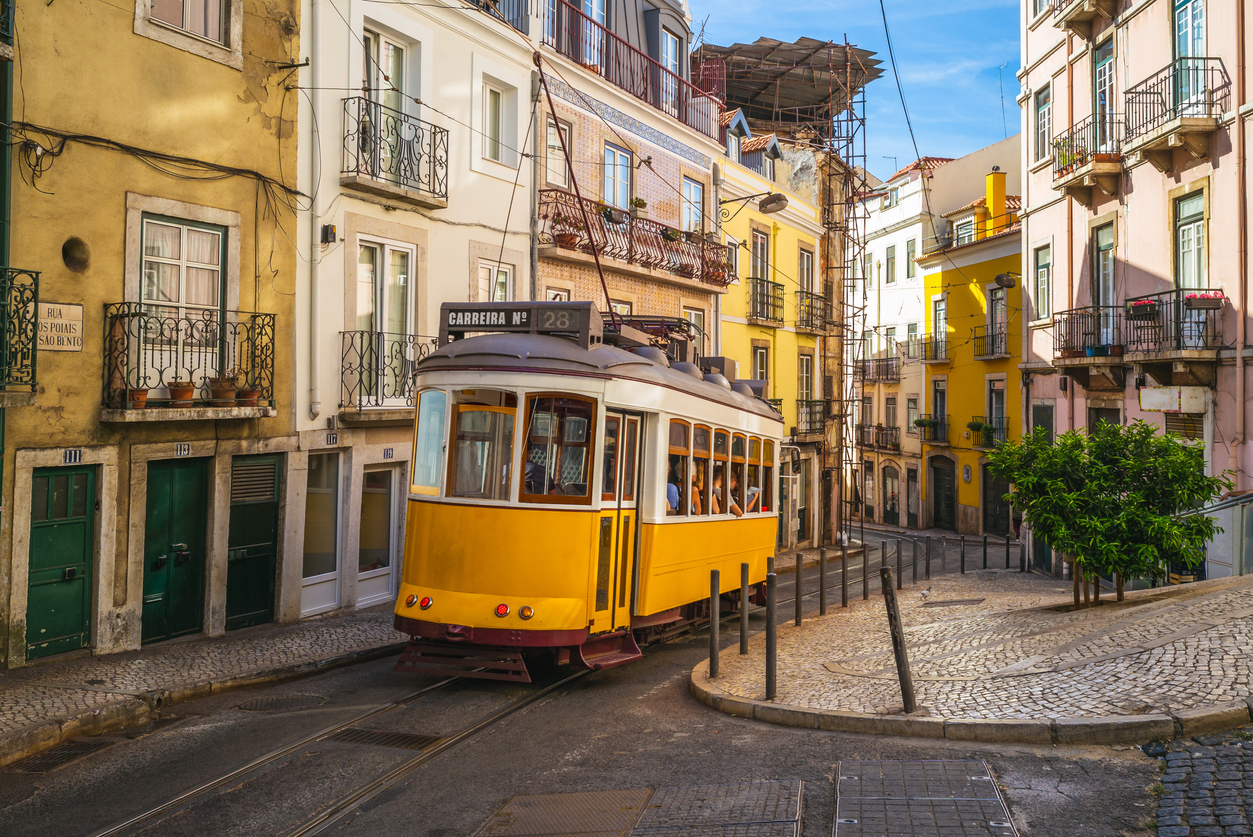Beyond pretty postcards, Portugal promises distinctive luxury experiences for discerning travellers seeking the extraordinary. As India’s premier bespoke tour provider, we uncover the “best places to visit in Portugal” in 2024 – the most enthralling sights, flavours, and adventures. Whether you desire exquisite wine tastings or private coastal cruises, we have it all.
1. A Weekend in Porto
Porto, also known as Oporto, is Portugal’s second biggest city. The city is along the Douro River estuary in northern Portugal, and it’s one of the oldest. UNESCO declared Porto’s city centre a World Heritage Site in 1996. The port wine, one of Portugal’s biggest exports, is named after Porto. The city is on the Portuguese Way Path of the Camino de Santiago.
With tile-covered churches, port wine tasting, and hearty sandwiches, Porto is the ultimate weekend city. It’s also worth checking out the fresh market, Mercado do Bolhão. The Capela das Almas is right next to the Mercado. Almost 16,000 tiles cover this beautiful 18th-century chapel. You can get a good cup of coffee at C’alma Coffee. You just need to wander down Rua da Santa Catarina, the heart of Porto’s commerce.
The city is small and compact, so you’ll be able to see most things on foot. The charming Ribeira neighbourhood is a must-see. Sunsets in Ribeira are amazing. Besides that, Ribeuira has a lot of restaurants. From vegan to seafood to traditional Portuguese food, to wine tastings in the cellar we can help you find it all.
2. Explore Sintra’s Charm
Located on the Portuguese Rivera, Sintra is part of the Greater Lisbon area of Portugal. It’s one of the most urbanised and densely populated municipalities in Portugal. It’s consistently ranked as one of the best places to live in Portugal.
A 25-minute drive from Lisbon, Sintra has palaces, ruins of castles, and elaborate villas that were once owned by royalty and aristocracy.
Among all the palaces and castles in Sintra, Pena Palace is the most famous. You’d think it’s a fairytale castle brought to life with its brightly coloured walls, turrets, and balconies.
Furthermore, there is the Moorish castle, which was built by the Moorish rulers in the 8th century. From its high vantage point, you could see the coastline and surrounding area
3. Hike or Drive Along the Algarve
Portugal’s southernmost region is the Algarve. There’s the Alentejo region of Portugal to the north, and the Atlantic Ocean to the west and south. There’s a little bit of Algarve that borders Spain.
It’s one of the warmest places in Europe. Algarve is best explored by car. You can get around by public transportation, but if you have a car, you can travel on your own schedule and visit some places that are hard to get to by bus.
Some of Europe’s best beaches are in the Algarve. You’ll find hidden coves and long stretches of golden sand in each of these gems.
Popular beaches include Marinha Beach, Praia da Falésia, and Praia do Camilo. The beautiful large towns to explore are Lagos and Portimao. Don’t miss Alvor, Carveiro, and Ferragudo, former fishing villages. If you’re into hiking, the Seven Hanging Valleys Trail is beautiful. The walk takes about 2-3 hours and is about 5.7 km. This walk takes you past Marina Beach, the Benagil Cave, and some of the best coastline in the Algarve.
4. Visit the University town of Coimbra
Coimbra is Portugal’s fourth-largest city after Lisbon, Porto, and Braga. From 1131 to 1255, Coimbra was Portugal’s capital. In addition, Coimbra is home to the oldest university in the Portuguese-speaking world, which opened in Lisbon in 1290 before moving to Coimbra in 1308.
Inside the University complex, the Capela de São Miguel is jaw-droppingly beautiful. After the palace and chapel, you must visit the Joanina Library. Inside the library, you will feel as if you have stepped into Beauty and the Beast. It consists of three huge, two-storey rooms. There are two levels of wooden bookshelves painted in deep hues of red, green, and blue. The shelves are stacked with books from the 16th to 18th centuries, which students can still take down and read
5. Hike the Otherworldly Mountains of Madeira
Located in the North Atlantic Ocean, Madeira is one of Portugal’s two autonomous regions along with the Azores.Funchal, the capital, is on the south coast. Madeira, Porto Santo, and Desertas make up the archipelago. A popular year-round resort, Madeira was the first land discovery of the Age of Discovery.
Known as “the paradise garden of the Atlantic”, Madeira has beautiful mountains, high cliffs, lava pools, dramatic landscapes, exotic flowers, waterfalls, but also dark, mostly pebble beaches.
It’s hard not to mention Cristiano Ronaldo… who was born in Madeira and is now the pride of the island. Even the airport was named after him.
Hikers love the island, but people with mobility challenges can also enjoy it. Viewpoints like Eira do Serrado or even Pico do Arieiro are easy to reach by car and offer stunning views without having to hike a lot.
Madeira also has beautiful botanical gardens, especially the Monte Palace & Madeira Botanical Garden. A cable car gets you to hidden places, like Fajã dos Padres, Rocha do Navio or Achadas da Cruz.
6. Experience Alentejo’s culinary and wine traditions
Alentejo is a geographical, historical, and cultural region in south-central and southern Portugal. Alentejo means beyond the Tagus River in Portuguese. Alentejo region has a Mediterranean climate and its main cities are Évora, Béja, and Sines.
Almost all of the region is dry, flat, and hot – summers here are scorching.
Travellers who want to see authentic Portugal and get a sense of the country’s history, culture, and cuisine should head to Alentejo.
Alto Alentejo is the most northern part of the region, with Portalegre as its capital. This sub-region mediaeval villages overlooking the Serra da Estrela Mountains. The hiking is excellent.
Central Alentejo is home to Evora, a famous UNESCO World Heritage Site, and a unique landscape of cork trees, olive groves, and vineyards.
The southernmost section of the Alentejo (Baixo Alentejo) is the postcard image of the Alentejo: rolling hills with sparse cork trees, interrupted occasionally by white-washed hamlets and mediaeval villages. It’s barren and harsh, but beautiful.
Alentejo Litoral is along the coast. There are great beaches in this region, referred to as the Sudoeste Alentejano, which are sometimes empty even during the high summer season.
7. Azores – The far out Portuguese Island for Hikes and Adventure
The Azores are part of the Portuguese autonomous region system, along with Madeira. The archipelago consists of nine volcanic islands in the North Atlantic Ocean, about 1,400 km from Lisbon and 1,500 km from Morocco. Agriculture, dairy farming, fishing, and tourism are the main industries in the region.
There’s nothing like the Azores for backpackers, hikers, and nature lovers. There are tons of things to do on San Miguel, the biggest island in the Azores. Ponta Delgada is the capital. You can wander through the historic streets, visit the 18th century church of Sao Sebastião, and also visit the Mercado da Graça.
You must also visit Sete Cidades, a twin lake system located in a volcanic crater. It’s actually one lake divided by a bridge, but it looks like two. Blue on one side, green on the other. The abandoned 5-star Hotel Monte Palace, perched on a mountaintop, offers some of the best views on the island.
Spend a day at Praia dos Moinhos if you’re a beach person. You can also drive to the eastern part of the island and explore Nordeste, a picturesque village. Be aware of your surroundings and drive carefully because it’s a pretty rugged island. San Miguel Island has the only tea plantations in Europe. Take a guided tour of Gorreana, Europe’s oldest tea plantation.
8. Uncover Lisbon’s Street Art
In the early 1970’s, graffiti and street art in Portugal emerged as a form of expression for marginalised voices, and flourished after the 1974 democratic revolution. The genre has evolved over the past couple of decades into vibrant, open-air murals that embrace socially impactful messages. Today, this transformation reflects the city’s dynamic cultural identity.
Lisbon is now recognized as a showcase for some of the best street art in Europe. From traditional graffiti to elaborate murals blending social commentary with stunning visual art,
From the environmentally conscious works of Bordalo II, who uses trash to create artwork depicting endangered species with striking realism, to the carved faces of Vhils’ politically charged pieces, and the colourful optimism of Mário Belém’s whimsical scenes, each is a vivid reflection of Lisbon’s artistic heartbeat.
Discover Lisbon’s creative edge by visiting ateliers, edgy exhibitions, and urban street art hubs that are usually closed off to tourists. Explore Lisbon as one of Europe’s most compelling emerging arts capitals with insider fashion designers, gallerists, and artists.
9. Peniche – Ride World-Class Waves with Pro Coaching
The city of Peniche is on the coast of Leiria. It’s built on a rocky peninsula. It’s known for its long beaches, surfing, bodyboarding, and kitesurfing.
Famous artists like French painter Maurice Boitel were inspired by its scenic harbour, white windmills, chapels, and long sandy beaches.
Take a private surf trip to the area’s renowned white sand beaches with expert coaching on navigating Portuguese world-class breaks like Supertubos and Carcavelos.
From June through September is the best time to visit Peniche, Portugal. While it’s high season and quite busy, it’s worth taking advantage of the long days and the festivals that occur in town.
Accommodations in Peniche vary from cozy guesthouses and luxurious hotels to budget-friendly apartments right on the beach.
With Worldpackers, you can stay in Peniche for free by volunteering. This platform connects travellers to hosts who need help in their businesses or nonprofits.
10. Évora – Full of History and Culture
Evora is a city and municipality in Portugal, with a well-preserved old town and many monuments from various historical periods, including a Roman temple, making it a UNESCO World Heritage Site.
Among all the things to do in Évora, the Roman Temple is a must-see. It dates all the way back to the first century – making it more than two thousand years old. Although it’s called the Temple of Diana, it was built in honour of Emperor Augustus.
Evora has a lot of churches and historic sites, but one of our favourite things to do is walk around. Whitewashed buildings with bright yellow trim line the quiet alleyways and cobblestone streets. You can get a glimpse of local life and the true spirit of this charming city just a few blocks from the main attractions.
Find out what Portugal has to offer in 2024 by letting us create your dream getaway. Our insider access lets you explore beyond well-worn tourist routes.



